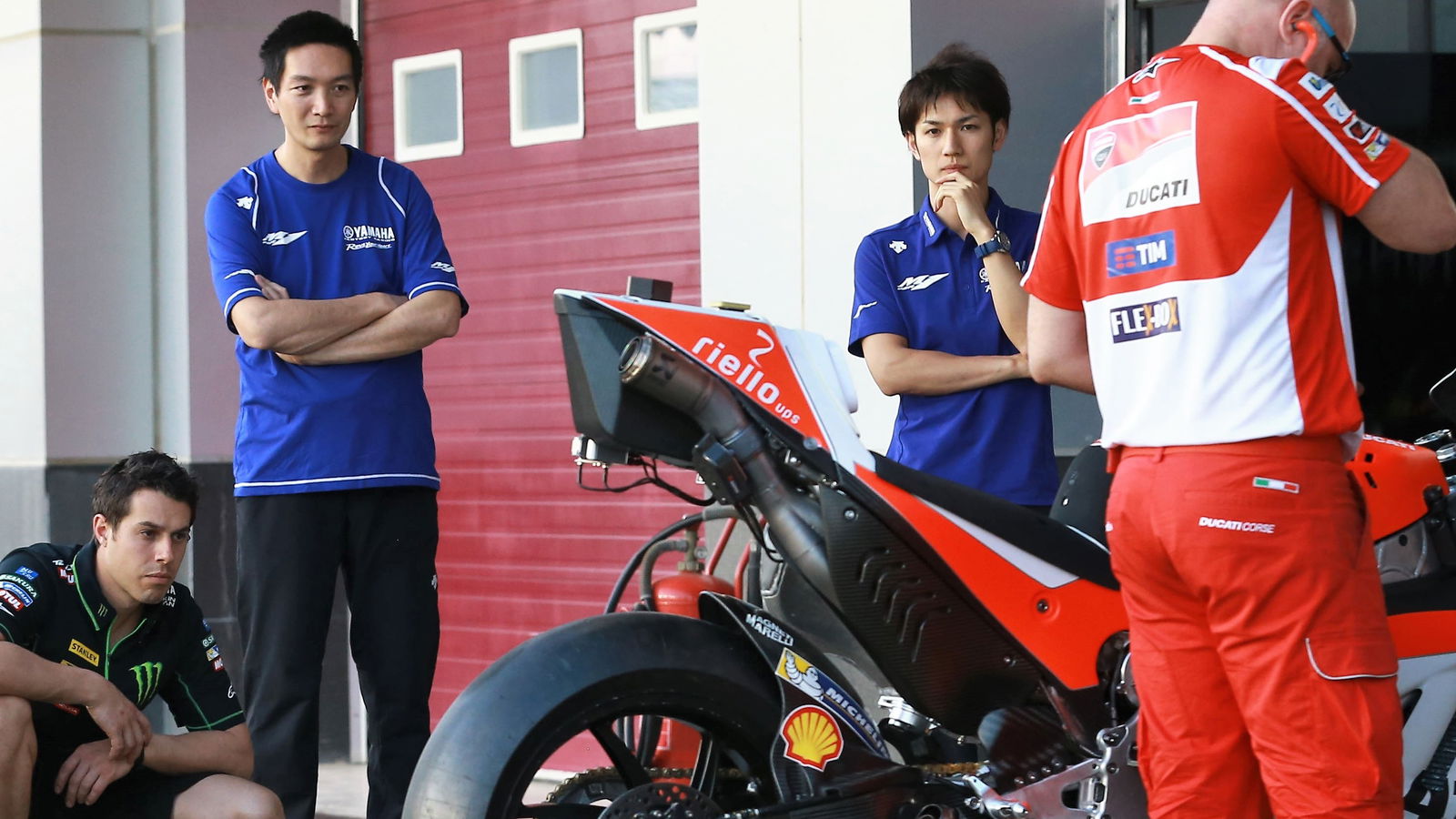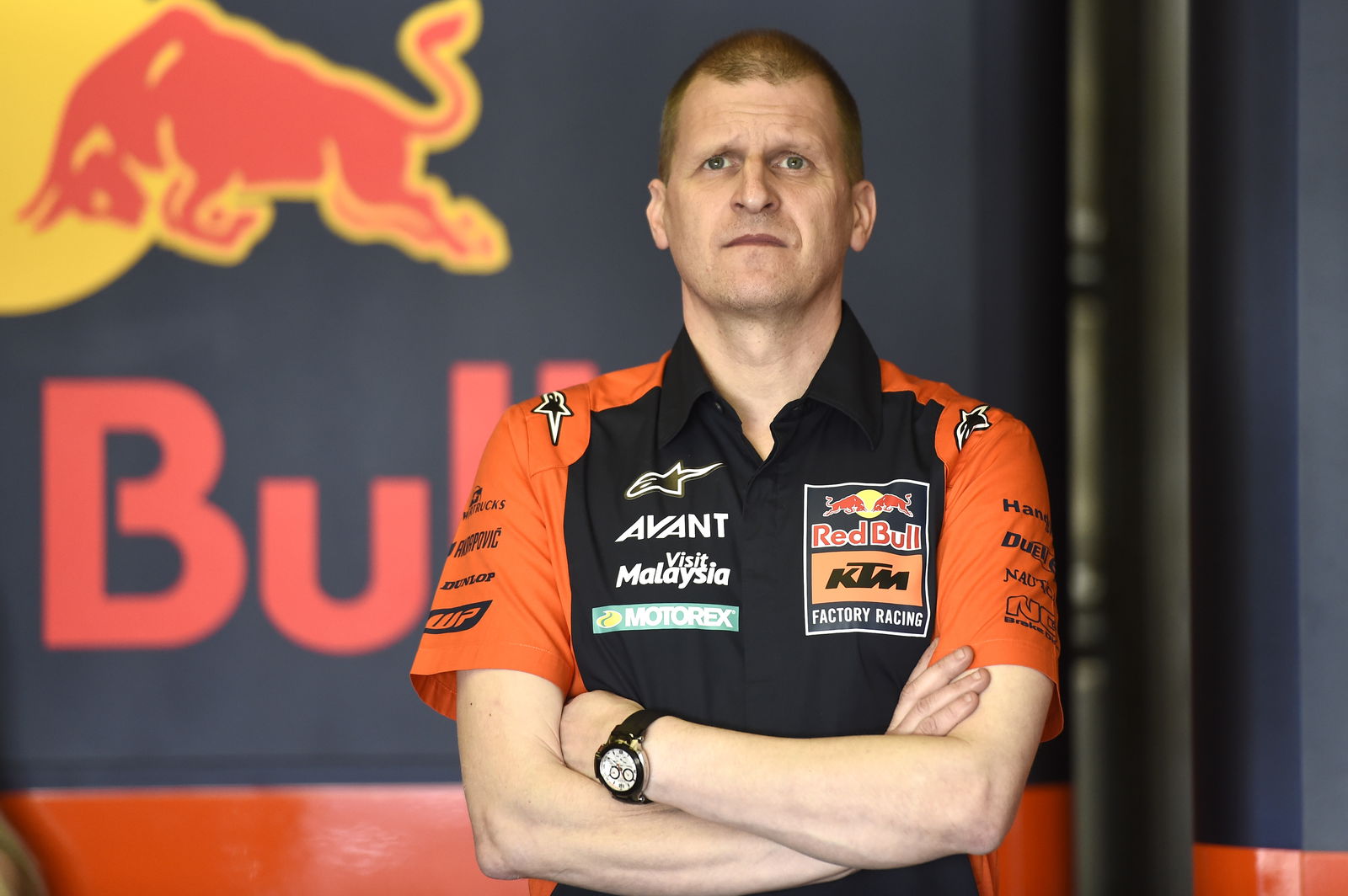MotoGP: Mass dampers, gyroscopes, MegaRide…
Since the mysterious 'salad box' was first seen on the back of the Ducati MotoGP bike in January, many theories have been put forward as to what it might contain.
The most common possibilities mooted include a storage area for the electronics, a mass damper or some kind of gyroscope.

Since the mysterious 'salad box' was first seen on the back of the Ducati MotoGP bike in January, many theories have been put forward as to what it might contain.
The most common possibilities mooted include a storage area for the electronics, a mass damper or some kind of gyroscope.
We spoke with MotoGP Director of Technology, Corrado Cecchinelli, about the two more interesting possibilities on that list - the discussion also covering Ducati's interest in data analysis company MegaRide…
Crash.net:
It’s still not clear what's inside the black box on the Ducati, one suggestion is that it might contain a mass damper. In general, what would be the purpose of a mass damper?
Corrado Cecchinelli:
A mass damper is a device that introduces some momentum or inertia, in reaction to a movement.
In the case of a suspension system, the basic 'school theory' is that you have something that opposes displacement, which is the spring. And something that reacts to the speed of the movement, which is the damper. At the moment damping technology is based on oil passing through orifices.
If you go on with this principle, a mass damper would oppose acceleration.
So you have displacement, the spring. Speed of movement, the damping. And acceleration of the movement, potentially a mass damper. In other words, you now have another item in the suspension system that controls the movement.
There is a bad way and a good way to do this.
The bad way is just to make things heavier.
Inertial mass dampers are a smarter way to do it, because you introduce inertia without a lot of weight. The general principal - I'm not talking about the case you mention [Ducati] - is to turn a flywheel, so with a limited amount of mass you have a bigger inertia.
So your suspension is connected to something which, using gearings or leverages, you spin so fast that you have a lot of inertia with a minimal amount of weight. Imagine in principal - this is not how they do it - a swingarm pushes a screw into a flywheel and turns the flywheel, soaking up the energy.
Crash.net:
In performance terms, what does the addition of a mass damper offer compared with a standard spring-and-shock suspension system?
Corrado Cecchinelli:
You are adding more control over the suspension movement, based on acceleration. And if you tune the mass - or more normally the inertia, because it rotates - it is particularly effective in damping critical movements of your specific system.
If your suspension has a resonance around 10hz for example, you can tune the mass damper to be particularly effective on that, regardless of the normal spring and damping.
So you can target specific behaviour with a mass damper and that in turn gives you more freedom to put the spring you would like and the shock absorber you would like, because you have already controlled the other issue.
But you pay a big price. You pay both by weight and by complication, so in general they are not used.
It was banned in Formula One because they considered it broke the rule on movable aerodynamics.
They decided the mass damper was not being used to improve the suspension function, but to help the car body stay in a fixed relationship to the ground, to have more effective aerodynamics.
So it was considered a moving aerodynamic device, because there was a mass moving, and that it was primarily to aid aerodynamics. So it was banned by that trick.
In Formula One, as far as I know, the mass damper was something in the car nose. When the nose of the car was going up and down, the mass was helping to soak up those movements and keep the car level.
Crash.net:
Would it be banned in MotoGP for the same reason?
Corrado Cecchinelli:
In MotoGP, I would not consider that. To me [the decision to ban as a moveable aerodynamic device] is already a bit borderline in cars, but for sure it could not be applied in MotoGP.
The position of the bodywork to the ground is not critical in MotoGP aerodynamics. So for me it would not be under our definition of a movable aerodynamic device.
Crash.net:
So if someone wanted to use a mass damper, it would be allowed?
Corrado Cecchinelli:
It would be allowed. For me the problem with using it in MotoGP would be, I would say, limited effect compared to the complication it would produce. If, by any chance you would consider to put it in the seat cowl [the 'salad box' on the Ducati], it's also a bad place to put weight.
So maybe you would pay too much. You would be adding weight in one of the worst places, but maybe gain something in the suspension movement. There is a big trade-off to me.
Crash.net:
How heavy do you think such a system would be?
Corrado Cecchinelli:
I really don’t know, but I think if you wanted a system to work we are talking about hundreds of grams to kilograms.
The only practical way I can imagine is not [under the back of the seat] but if the shock absorber rod is threaded and spins a flywheel coaxial to the shock absorber. This to me is the only reasonable way to do it on a bike because you are not that far from the swingarm pivot, so you pay less for putting weight in that area and you don’t have linkages.
If you were to put a system under the seat you would need to imagine a way to transfer the movement to that area, so linkages or things that are crazy to me and make it so complicated that you would decide not to do it.
But I don't know…
Furthermore, any electric/electronic way of moving masses/flywheels would be banned because it is a chassis control strategy, on top of the unified software.
So in the end, I don't think they [Ducati] have it, but maybe they are just smarter than me and found a way to do it!
To me the only way on a bike, would be to incorporate a mass damper on a shock absorber.
Crash.net:
Is it possible to create a mass damper powered hydraulically?
Corrado Cecchinelli:
Yes. You can link it hydraulically to the suspension. You would maybe use the suspension as a pump and spin a flywheel located somewhere else. But again, it's complicated!
Crash.net:
Assuming that it could somehow be done in MotoGP. The main effect would be to enhance tyre performance?
Corrado Cecchinelli:
That would be the goal. What you are most interested in is controlling the force on the ground, because this tyre force is constantly oscillating up and down due to the movement of the shock.
So you have an average tyre force, but with upper and lower magnitudes. The critical part is the lower magnitude, the minimum tyre force on the ground, because that is when you lose traction. If you can use the mass damper to increase this minimum tyre force, it means the tyre is pressing onto the track more.
If suddenly you have less force than you need, you will either crash or the electronics will cut the power. So you are interested in increasing this minimum force to the ground.
Crash.net:
Talking about tyre performance, the Italian company MegaRide - which specialises in data-related tyre dynamics - has been in the news for a potential partnership with Ducati. To clarify, with the unified software, teams can put their own numbers into the system but not change the way the actual strategies work?
Corrado Cecchinelli:
I'm not sure exactly what they [MegaRide] do, but I guess they could make a sort of statistical analysis of some parameters to find better calibrations for the unified software strategies.
Maybe they could find out something related to tyre degradation and as we don't have adaptive strategies [strategies, like traction control, which change automatically during the race] they might find something like, 'from mid-race onwards, switch to this map which is best for used tyres'.
They cannot really change the strategies, just build and handle a database to find better calibrations.
But yes, it's like you say, you have to put in the numbers.
A simple example: You have to input your target wheelspin, given the lean angle. Everybody has the same strategy that aims to deliver their target spin at a given lean angle, but the value of that target spin is up to you.
That is where a team can be different from the others. Not by the way in which the strategy acts, but by the target inputs.
Crash.net:
You can tell the ECU what you want the bike to do, but the way it does it is the same for everybody?
Corrado Cecchinelli:
Yes. For instance, you may input 10% of spin at 40-degrees of lean. And another team may want 12% at the same lean angle.
The way the strategy would handle those two different inputs, 10% and 12%, would be exactly the same. Only the input value would be different.
So to return to your original question, maybe they [MegaRide] can make such a good statistical analysis that they are able to provide a team with better input values.
Crash.net:
Returning to Ducati, some people in the paddock are sure the 'salad box' contains what looks like a gyroscope. What might this be for?
Corrado Cecchinelli:
No idea. If by 'gyroscope' we mean a lean/pitch angle sensor, that may just be a part of a more complicated - and possibly better - IMU [inertial measurement unit], as proprietary IMUs are allowed*.
Otherwise I wouldn't really know…
*The IMU is not covered by MotoGP's unified software rules, although Cecchinelli thinks they should be.
Part 2 of the interview will look at the potential use of two F1 technology 'loopholes' in MotoGP.


